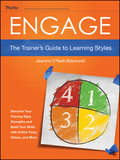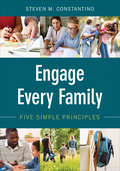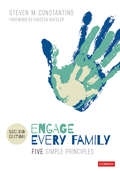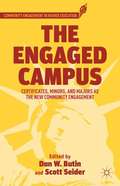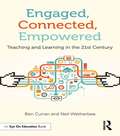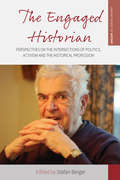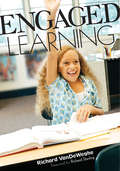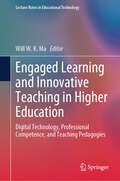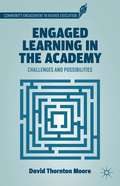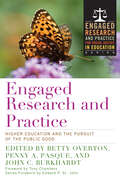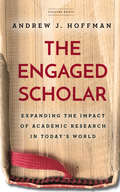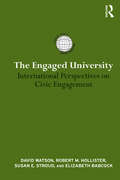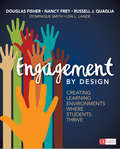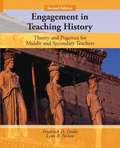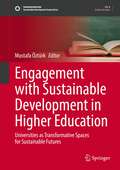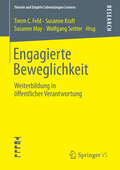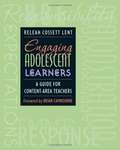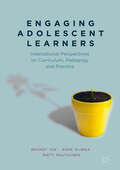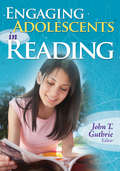- Table View
- List View
ENG 214 How to Read a Short Story S.Y.B.A. - Y.C.M.O.U
by Chandrashekhar Jahagirdar Prin. K. J. Purohit A. K. Joshi A. N. Pednekar R. B. Patankar Vishwas Kanadey Yasmeen Lukmani Shirish Chindhade Aniket Are Bhalachandra Nemade.ENG 214 How to Read a Short Story text book for S.Y.B.A from Yashwantrao Chavan Maharashtra Open University, Nashik in English.
ENG 215 How to Read a Novel S.Y.B.A. - Y.C.M.O.U
by Prof. V. H. Kshirsagar Pramod Kulkarni Aniket Jaware Anil Pathak Ramesh Dnyate Vilas SalunkeENG 215 How to Read a Novel text book for S.Y.B.A from Yashwantrao Chavan Maharashtra Open University, Nashik in English.
Engage
by Jeanine O'Neill-BlackwellDiscover Your Training Style Strengths and Build Your Skills with Online Tools, Videos, and More"A superb book that gives learning and development professionals in every industry an automatic must-read. This book is filled with wisdom and insight as well as clear analytic models and real actionable concrete steps." -- Bruce Tulgan, author of It's OK to Be the Boss and Managing Generation X"Engage takes the innovation of 4MAT® and looks at it through the lens of the trainer. An engaging learning experience itself, Engage is full of interactive assessments, links to videos, and foolproof action plans and ideas designed to transform any learning event into a dynamic learning experience."-- Shelley Barnes, executive director, Field Education/Program Development, Aveda CorporationFor any trainer who needs easy-to-apply strategies that are grounded in solid research, Engage offers a hands-on guide to understanding learning styles. It includes a four-step model for engaging all learning styles in any learning situation. The book integrates both the art and research-based science of strong instructional design reaching all learning styles with activities, tricks, and tips that are proven to boost skills quickly.Filled with illustrative examples and online companion resources, the book explores the brain research that lays the foundation for the book's 4MAT? model and includes activities and strategies that can be applied for each step in the process. Engage also gives the reader access to an online version of the 4MAT? Training Style Inventory. The results of the assessment give a strengths score in four key training roles.
Engage Every Family: Five Simple Principles
by Dr Steven M. ConstantinoReach beyond theory and engage every family in student success Family engagement increases student achievement but how do schools connect with families who don’t participate yet? Educators can easily become frustrated trying to reach the disconnected and often fall back to engaging the already engaged. Is it possible to win over everyone? Discover how to move beyond theory to change your culture for better family engagement and student achievement. Through practical steps, reflections, and case studies, you will discover and address: How and where family engagement breaks down, and How to create a truly inviting culture for successful community and family partnerships
Engage Every Family: Five Simple Principles
by Dr Steven M. ConstantinoReach beyond theory and engage every family in student success Family engagement increases student achievement but how do schools connect with families who don’t participate yet? Educators can easily become frustrated trying to reach the disconnected and often fall back to engaging the already engaged. Is it possible to win over everyone? Discover how to move beyond theory to change your culture for better family engagement and student achievement. Through practical steps, reflections, and case studies, you will discover and address: How and where family engagement breaks down, and How to create a truly inviting culture for successful community and family partnerships
Engage Every Family: Five Simple Principles
by Dr. Steven Mark ConstantinoNew and Improved - Revisit Five Simple Principles and Engage With Every Family Join Dr. Steve Constantino as he outlines a pathway and process to engage every family on the journey toward improved student learning, including the traditionally disengaged. Revisions and additions include updated research to ensure a firmer foundation for each of its five simple principles as well as: ? A deeper dive into the idea of empowering families to work alongside teachers for improved learning ? A subtle switch from building to developing relationships, and how trust is at the core of that difference ? Reflections about implicit bias, equitable learning outcomes, and the role family engagement plays
Engage Every Family: Five Simple Principles
by Dr. Steven Mark ConstantinoNew and Improved - Revisit Five Simple Principles and Engage With Every Family Join Dr. Steve Constantino as he outlines a pathway and process to engage every family on the journey toward improved student learning, including the traditionally disengaged. Revisions and additions include updated research to ensure a firmer foundation for each of its five simple principles as well as: ? A deeper dive into the idea of empowering families to work alongside teachers for improved learning ? A subtle switch from building to developing relationships, and how trust is at the core of that difference ? Reflections about implicit bias, equitable learning outcomes, and the role family engagement plays
The Engaged Campus
by Dan W. Butin Scott SeiderThe Engaged Campus offers a set of emerging best practices and articulation of critical issues for faculty and administrators committed to developing, strengthening, or expanding majors or minors in community engagement at their respective institutions.
Engaged, Connected, Empowered: Teaching and Learning in the 21st Century
by Ben Curran Neil WetherbeeThis reader-friendly book offers practical strategies and digital resources that will help K–12 students succeed in the 21st century. You will learn how to teach students to collaborate and make connections, filter primary source information, create products to demonstrate learning, develop a digital toolkit, and more! Special Features: Digital resources are included to help you implement the ideas in this book. Personal anecdotes are provided from the authors’ own successes and failures using technology. The book is organized by topic, so you can skip around and read or reread the parts that are relevant to you. The authors provide suggestions for teachers at different comfort levels with technology--novice, intermediate, and expert. The book’s accompanying Facebook page includes additional content and links to complement the book (http://facebook.com/EngagedConnectedEmpowered).
The Engaged Historian: Perspectives on the Intersections of Politics, Activism and the Historical Profession (Making Sense of History #37)
by Stefan BergerOn the surface, historical scholarship might seem thoroughly incompatible with political engagement: the ideal historian, many imagine, is a disinterested observer focused exclusively on the past. In truth, however, political action and historical research have been deeply intertwined for as long as the historical profession has existed. In this insightful collection, practicing historians analyze, reflect on, and share their experiences of this complex relationship. From the influence of historical scholarship on world political leaders to the present-day participation of researchers in post-conflict societies and the Occupy movement, these studies afford distinctive, humane, and stimulating views on historical practice and practitioners
Engaged Learning
by Richard P. VanDeWegheBased on the idea of "flow"—a state of intrinsic control, curiosity, interest, and inquiry—this book provides strategies for encouraging students to become motivated, engaged learners.
Engaged Learning and Innovative Teaching in Higher Education: Digital Technology, Professional Competence, and Teaching Pedagogies (Lecture Notes in Educational Technology)
by Will W. K. MaThis book presents research studies investigating innovative curriculum design, effective teaching pedagogies, skilling and assessment of relevant competencies, and innovative and learning-associated technology. The book is categorized into three sections: (I) Innovative and digital learning environments; (II) Assessment and development of future professional competencies; and (III) Innovative curriculum design and teaching pedagogies. It serves as a useful resource for academic instruction in higher education. Employers, administrators, practitioners, postgraduate students, and postsecondary students in general will also find it informative.
Engaged Learning in the Academy
by David Thornton MooreMoore asks the question of whether and under what conditions experience constitutes a legitimate source of knowledge and learning in higher education. Drawing on theory and research, the book addresses three types of challenges and opportunities facing experiential educators: the epistemological, the pedagogical, and the institutional.
Engaged Research and Practice: Higher Education and the Pursuit of the Public Good
by Betty Overton Penny A. Pasque John C. BurkhardtWhat practices can researchers use to gain a more nuanced understanding of educational issues in the community and be part of the solution to those issues?Engaged Research and Practice is about two prevailing and complementary ideas that have surfaced in the higher education arena: engaged research and higher education for the public good. Engaged research is scholarship that not only attempts to open up new knowledge, but it does so with a sense that the new knowledge, insight and directions have a direct relationship to needs and problems within our communities, institutions, and policy arenas. Engaged, actionable, or participatory research and scholarship attempts to tackle the identified issues of our communities and society. This handbook offers important insights and tangible examples of how higher education leaders may work directly with communities and in policy settings to understand the deeper meanings often lost in conversations about educational opportunity. Each chapter addresses the ways in which faculty, community and administrative leaders may connect research and practice through unique research projects. The authors offer clear explanations of "how" their engaged research was conducted to illustrate explicit pathways for practitioners. This book also includes short narratives where authors involved with this research reflect on their experiences and the lessons they have learned while immersed in community and policy related work.
The Engaged Scholar: Expanding the Impact of Academic Research in Today’s World
by Andrew J. HoffmanSociety and democracy are ever threatened by the fall of fact. Rigorous analysis of facts, the hard boundary between truth and opinion, and fidelity to reputable sources of factual information are all in alarming decline. A 2018 report published by the RAND Corporation labeled this problem "truth decay" and Andrew J. Hoffman lays the challenge of fixing it at the door of the academy. But, as he points out, academia is prevented from carrying this out due to its own existential crisis—a crisis of relevance. Scholarship rarely moves very far beyond the walls of the academy and is certainly not accessing the primarily civic spaces it needs to reach in order to mitigate truth corruption. In this brief but compelling book, Hoffman draws upon existing literature and personal experience to bring attention to the problem of academic insularity—where it comes from and where, if left to grow unchecked, it will go—and argues for the emergence of a more publicly and politically engaged scholar. This book is a call to make that path toward public engagement more acceptable and legitimate for those who do it; to enlarge the tent to be inclusive of multiple ways that one enacts the role of academic scholar in today's world.
The Engaged University: International Perspectives on Civic Engagement (International Studies in Higher Education)
by David Watson Robert Hollister Susan E. Stroud Elizabeth BabcockThe Engaged University is a comprehensive empirical account of the global civic engagement movement in higher education. In universities around the world, something extraordinary is underway. Mobilizing their human and intellectual resources, institutions of higher education are directly tackling community problems – combating poverty, improving public health, and restoring environmental quality. This book documents and analyzes this exciting trend through studies of civic engagement and social responsibility at twenty institutions worldwide. This timely volume offers three special contributions to the literature on higher education policy and practice: a historical overview of the founding purposes of universities, which almost invariably included a context-specific element of social purpose, together with a survey of how these "founding" intentions have fared in different systems of higher education; a contemporary account of the policy and practice of universities – all over the world – seeking to re-engage with this social purpose; and an overview of generic issues which emerge for the "engaged university."
Engagement by Design: Creating Learning Environments Where Students Thrive (Corwin Literacy)
by Douglas Fisher Dr Nancy Frey Dr Russell J. Quaglia Dr Lisa L. Lande Dominique SmithEngaging Students for Success Through Purposeful Design Every teacher wants engaged students. No student wants to be bored. So why isn’t every classroom teeming with discussion and activity centered on the day’s learning expectations? Engagement by Design gives you a framework for making daily improvements in engaging your students, highlighting opportunities that offer the greatest benefit in the least amount of time. You’ll learn how focusing on relationships, clarity, and challenge can make all the difference in forging a real connection with students. Engagement by Design puts you in control of managing your classroom’s success and increasing student learning, one motivated student at a time.
Engagement by Design: Creating Learning Environments Where Students Thrive (Corwin Literacy)
by Douglas Fisher Dr Nancy Frey Dr Russell J. Quaglia Dr Lisa L. Lande Dominique SmithEngaging Students for Success Through Purposeful Design Every teacher wants engaged students. No student wants to be bored. So why isn’t every classroom teeming with discussion and activity centered on the day’s learning expectations? Engagement by Design gives you a framework for making daily improvements in engaging your students, highlighting opportunities that offer the greatest benefit in the least amount of time. You’ll learn how focusing on relationships, clarity, and challenge can make all the difference in forging a real connection with students. Engagement by Design puts you in control of managing your classroom’s success and increasing student learning, one motivated student at a time.
Engagement in Teaching History: Theory and Practices for Middle and Secondary Teachers
by Frederick D. Drake Lynn R. NelsonHow can history be taught effectively? Does knowing about the past give meaning to the present and hints to what will happen in the future? This book responds to these questions as it explores the key elements of history instruction–the use of primary sources and narratives, involving students in the historical inquiry through classroom discussions, teaching toward chronological thinking, and the use of historical documents to develop in students a “detective approach” to solving historical problems. Taking a systematic approach to improve students’ historical thinking, this book emphasizes certain strategies that will help students know more about the past in ways that will help them in their lives today. <P><P> The second edition is organized in three parts–Part One describes the theoretical background to teaching history. Part Two, Planning and Assessment, emphasizes the importance of good organization and lesson planning as well as how to assess students’ knowledge, reasoning power, and effective use of communication in the history classroom. Part Three, Instruction, focuses on the use of primary sources, class discussions, incorporating photographs and paintings, and writing in teaching history. Both the study of history and the teaching of history are multifaceted. The author’s hope in writing this book is to engage new and experienced teachers in thoughtful discourse regarding the teaching and learning of history and to develop lifelong learners of history in the 21st century.
Engagement in Teaching History: Theory and Practices for Middle and Secondary Teachers
by Frederick D. Drake Lynn R. NelsonWith an emphasis on engaging students in historical inquiry, problem solving, and discussion, Engagement in Teaching History offers a wealth of ideas for prospective teachers of history. The book addresses the selection of content, methods of instruction, and ways to assess students' learning. By following the text's guidelines for involving learners in historical inquiry, teaching toward chronological thinking, encouraging deliberative discussions, and using primary sources, teachers will ignite students' innate "detective" instincts and encourage them to think critically about historical events.
Engagement with Sustainable Development in Higher Education: Universities as Transformative Spaces for Sustainable Futures (Sustainable Development Goals Series)
by Mustafa ÖztürkThis edited volume analyzes cases of higher education programs engaging with sustainable development. Offering cases from across the globe that focus on the role of universities in promoting societal transformations and building sustainable futures, the volume specifically discusses how higher education institutions can educate for the Sustainable Development Goals (SDGs). As critical spaces for research, development, and innovation, higher education institutions are fundamental change agents for societal transformations. Their role in disseminating sustainability through different paths is undeniable, and it is worth discussing the dimensions that surround the concept of sustainability within universities. Considering the role of policy, curriculum, practice, teaching, research, and development paths in universities, this book looks at the contributions of higher education sector to our vision of sustainable development. This publication offers readers a chance to look at different higher education institutions’ engagement with sustainable development through political, managerial, curricular and practical steps.
Engagierte Beweglichkeit
by Timm C. Feld Susanne Kraft Susanne May Wolfgang SeitterAusbau und Verstetigung einer inklusiven Bildungsinfrastruktur für das Lernen Erwachsener sind dezidierte Aufgaben öffentlicher Weiterbildung. Grundversorgung, Zugänglichkeit und Bildungsgerechtigkeit signalisieren die politisch-gesellschaftliche Dimension der Aufgabenstellung, ein effizientes Management die ökonomische Dimension. Beide Perspektiven stehen im Zentrum dieses Bandes, der Klaus Meisel zum 60. Geburtstag gewidmet ist. Engagierte Beweglichkeit kann in institutioneller Perspektive als gleichzeitige Fokussierung auf Infrastruktur- und Angebotsgestaltung für das Lernen Erwachsener und auf wirtschaftlicheRessourcenoptimierung und Sparsamkeit gedeutet werden. In professioneller Perspektive verweist sie auf das habitualisierte Handeln der verantwortlichen Akteure, die nicht nur die Gestaltung des Lernens, sondern auch die Gestaltung in und an der Organisation in Bewegung bringen.
Engaging Adolescent Learners: A Guide for Content-area Teachers
by Releah Cossett LentExamine what it means to engage young adults in their learning and find out what classrooms with engaged students look, sound, and feel like. Let Releah Lent help you transform your classrooms into places where students have the freedom to satisfy their natural inclination to explore. With Engaging Adolescent Learners at your side, you'll have everything you need to help even the most reluctant students find a way to learn that works for them.
Engaging Adolescent Learners: International Perspectives on Curriculum, Pedagogy and Practice
by Brandy Yee Anne Sliwka Matti RautiainenThis book draws on detailed case studies from three very different countries and school systems to explore the early adolescent learner and the middle years of learning, both of which are often overlooked in the literature. An abundance of research shows the importance of the middle years in putting early adolescent learners on the path to success in further education, careers, and general wellbeing. By focusing on bringing current research to life through the sharing of practical examples and lived experiences of practitioners, this book explores how issues such as curriculum reform, inclusive philosophies, instructional design, and assessment practices are supporting the conditions in which effective middle years learning can unfold. A comparative approach, using data from Canada, Germany and Finland, is utilized to critically examine the effects of the pedagogical methods employed by teachers, and the learning environments in which formal education takes place. The book makes a compelling case for the importance of fostering student voice and choice, and developing new ways of engaging the school community as a whole, and makes a valuable contribution to the discourse concerning early adolescent learners and the middle years of schooling.
Engaging Adolescents in Reading
by John T. GuthrieWith contributions from content teachers, this insightful book discusses instructional approaches, student activities, and textbooks that can motivate reluctant learners to become active readers.

